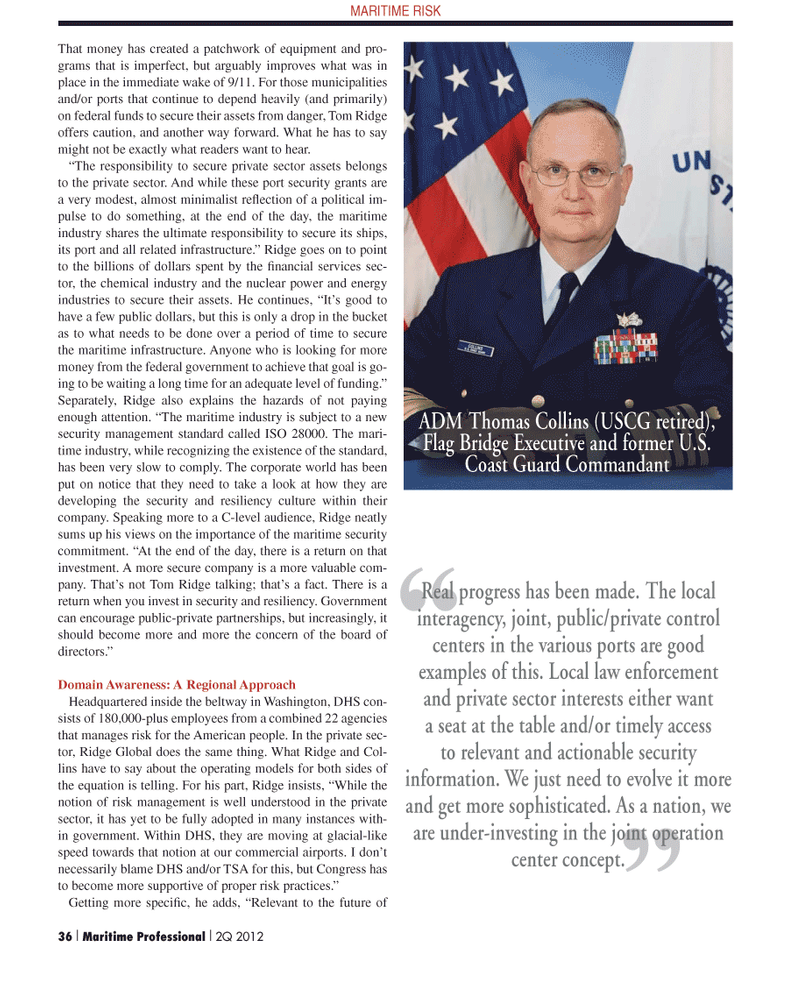
Page 36: of Maritime Logistics Professional Magazine (Q2 2012)
Maritime Risk
Read this page in Pdf, Flash or Html5 edition of Q2 2012 Maritime Logistics Professional Magazine
That money has created a patchwork of equipment and pro- grams that is imperfect, but arguably improves what was in place in the immediate wake of 9/11. For those municipalities and/or ports that continue to depend heavily (and primarily) on federal funds to secure their assets from danger, Tom Ridge offers caution, and another way forward. What he has to say might not be exactly what readers want to hear. “The responsibility to secure private sector assets belongs to the private sector. And while these port security grants are a very modest, almost minimalist refl ection of a political im- pulse to do something, at the end of the day, the maritime industry shares the ultimate responsibility to secure its ships, its port and all related infrastructure.” Ridge goes on to point to the billions of dollars spent by the fi nancial services sec- tor, the chemical industry and the nuclear power and energy industries to secure their assets. He continues, “It’s good to have a few public dollars, but this is only a drop in the bucket as to what needs to be done over a period of time to secure the maritime infrastructure. Anyone who is looking for more money from the federal government to achieve that goal is go- ing to be waiting a long time for an adequate level of funding.”
Separately, Ridge also explains the hazards of not paying enough attention. “The maritime industry is subject to a new security management standard called ISO 28000. The mari- time industry, while recognizing the existence of the standard, has been very slow to comply. The corporate world has been put on notice that they need to take a look at how they are developing the security and resiliency culture within their company. Speaking more to a C-level audience, Ridge neatly sums up his views on the importance of the maritime security commitment. “At the end of the day, there is a return on that investment. A more secure company is a more valuable com- pany. That’s not Tom Ridge talking; that’s a fact. There is a return when you invest in security and resiliency. Government can encourage public-private partnerships, but increasingly, it should become more and more the concern of the board of directors.”
Domain Awareness: A Regional Approach
Headquartered inside the beltway in Washington, DHS con- sists of 180,000-plus employees from a combined 22 agencies that manages risk for the American people. In the private sec- tor, Ridge Global does the same thing. What Ridge and Col- lins have to say about the operating models for both sides of the equation is telling. For his part, Ridge insists, “While the notion of risk management is well understood in the private sector, it has yet to be fully adopted in many instances with- in government. Within DHS, they are moving at glacial-like speed towards that notion at our commercial airports. I don’t necessarily blame DHS and/or TSA for this, but Congress has to become more supportive of proper risk practices.”
Getting more specifi c, he adds, “Relevant to the future of ” “
Real progress has been made. The local interagency, joint, public/private control centers in the various ports are good examples of this. Local law enforcement and private sector interests either want a seat at the table and/or timely access to relevant and actionable security information. We just need to evolve it more and get more sophisticated. As a nation, we are under-investing in the joint operation center concept.
ADM Thomas Collins (USCG retired),
Flag Bridge Executive and former U.S.
Coast Guard Commandant
MARITIME RISK 36 I Maritime Professional I 2Q 2012
MP #2 34-49 NEW STYLES.indd 36 5/4/2012 5:12:01 PM

 35
35

 37
37
